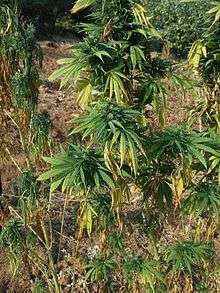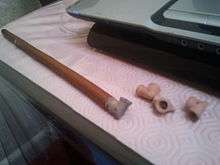Cannabis in Morocco

Cannabis in Morocco has been illegal since the nation's independence in 1956, reaffirmed by a total ban on drugs in 1974, but is partially tolerated in the country, where it has been cultivated for centuries and is still among the world's top producers of hashish.
History
Early history
Though the specific period of cannabis's introduction to Morocco is unclear, it appears to have arrived in the region during the Arab invasions of the Maghreb, from the seventh to fifteenth centuries. From the sixteenth century it was grown nationwide on a small scale for local use, in gardens and orchards, but it was only in the 18th century that the Rif region in the far north became a noted center of production, as it is in modern times.[1] In 1890, Sultan Hassan I instituted strict regulations on cultivation and trade, but also conferred clear cannabis production privileges on several Rif tribes.[2][1] In the 1950s, the rights of the Rif tribes to cultivate cannabis was reconfirmed, in response to tensions in the restive region.[2] In 1956, with the new independence of Morocco, King Mohammed V prohibited cannabis nationwide.[3]
Internationalization
In the 1960s and 1970s, an influx of young Western tourists had a profound effect on cannabis in Morocco. Prior to this, cannabis was produced in small quantities, and smoked as kief, pollen mixed with black tobacco. In response to massive demand from tourists and smugglers, Moroccans adopted larger-scale techniques to replace artisanal ones.[4] While there are competing legends as to how hashish production was introduced to Morocco, it is widely believed that it happened during this period.[5]
Production
Morocco produces a substantial portion of the world's hashish; it was the top producer for the 2002-2010 period before a 2012 study placed Afghanistan as the top producer. Morocco's 2010 production was 760 tons of cannabis resin.[6] In 2003, 70% of Europe's hashish consumed was produced in Morocco.[7]
In traditional production, cannabis stalks are cut from the field in autumn and stored indoors to dry for a month. The men then place the dried stalks onto a fine fabric stretched across a metal basin, and beat the stalks, causing the THC-laden trichomes to fall into the basin for collection. The first kif beaten from the stalks is of the best quality, and the stalks can be further beaten a second and third time, albeit producing a lower-quality product. Some of the trichomes are packaged as-is, or they can be repeatedly pressed and heated to form dense slabs of hashish. Hashish slabs are often marked with an emblem indicating its producer, such as an abstract design, number, or imitation of a commercial logo. These symbols have no standardization or consistency season-to-season, but serve in the short term to mark the current output of a given producer.[8]
Cannabis culture

Prior to the internationalization of the cannabis trade, Moroccan cannabis was consumed locally, smoked in a long sebsi pipe or mixed into food, and was also used in Sufi religious rituals.[9]
Majoun is a popular traditional edible, a candy or jam made of cannabis with honey and spices.[10]
Legalization debate
Cannabis was banned in Morocco following independence, but the traditional tolerance for its production in the Rif, and the practical recognition that cannabis makes up a large share of the national economy, has led to debate as to legalizing cannabis. In 2009, Fouad Ali el Himma received multipartisan support amongst Moroccan politicians for his proposal to re-brand cannabis as a traditional Moroccan herbal remedy rather than a dangerous drug, and called for national debate and reduced prosecution of farmers.[11] In 2014, the Party of Authenticity and Modernity proposed a draft law which would keep consumption of recreational cannabis illegal, but would license and regulate growers and redirect their output to licit medicinal and industrial cannabis products.[12][4]
References
- 1 2 Mr Martin Bouchard; Mr Tom Decorte; Dr Gary Potter (28 January 2013). World Wide Weed: Global Trends in Cannabis Cultivation and its Control. Ashgate Publishing, Ltd. pp. 40–. ISBN 978-1-4094-9438-6.
- 1 2 Fredrik Söderbaum; Ian Taylor; Nordiska Afrikainstitutet (2008). Afro-regions: The Dynamics of Cross-border Micro-regionalism in Africa. Stylus Pub Llc. p. 130. ISBN 978-91-7106-618-3.
- ↑ Stephen Roffe (27 March 2014). Beyond Hercules: An inside story of the Moroccan hash trade. Indie Publishing Limited. pp. 90–. ISBN 978-0-9927455-0-9.
- 1 2 Brian Preston (2002). Pot Planet: Adventures in Global Marijuana Culture. Grove Press. pp. 197–. ISBN 978-0-8021-3897-2.
- ↑ Robert Connell Clarke (1998). Hashish!. Red Eye Press. ISBN 978-0-929349-05-3.
- ↑ "Morocco, no longer the World's Largest Producer of Cannabis- UN report". Morocco World News. Retrieved 28 July 2015.
- ↑ Giles Tremlett. "Ketama Gold puts Morocco top of Europe's cannabis league". the Guardian. Retrieved 28 July 2015.
- ↑ Bob J. Zehmer (22 May 2013). Kif: Hashish from Morocco. eBookIt.com. pp. 74–. ISBN 978-1-4566-0020-4.
- ↑ Josep Lluís Mateo Dieste (12 October 2012). Health and Ritual in Morocco: Conceptions of the Body and Healing Practices. BRILL. pp. 109–. ISBN 978-90-04-23448-2.
- ↑ Paul Bowles; Gena Dagel Caponi (1993). Conversations with Paul Bowles. Univ. Press of Mississippi. pp. 62–. ISBN 978-0-87805-650-7.
- ↑ "Morocco's growing Cannabis debate". Foreign Policy.
- ↑ "Morocco, top hash provider, mulls legislation to break marijuana taboo and legalize growing". The Globe and Mail.
